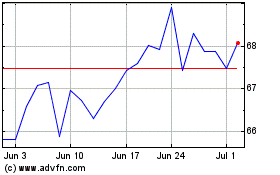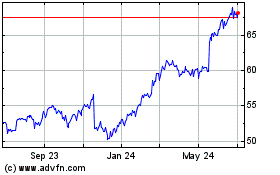Wal-Mart Appoints New CFO, Top Merchant -- 3rd Update
October 09 2015 - 12:52PM
Dow Jones News
By Sarah Nassauer And Ezequiel Minaya
Wal-Mart Stores Inc. shuffled its management ranks on Friday,
appointing a new chief financial officer and a top merchant as the
world's largest retailer looks to revive weak sales growth.
Doug McMillon, Wal-Mart's CEO since 2013, is revamping his team
after warning in August that annual profits would miss forecasts
and announcing this month a round of job cuts at the company's
Bentonville, Ark., headquarters. The executive changes come ahead
of a meeting with investors and analysts scheduled for Oct 14.
Wal-Mart said CFO Charles Holley, 59 years old, will retire at
the end of the year and be replaced by 47-year-old Brett Biggs, who
is currently CFO of Wal-Mart International. Mr. Holley has been CFO
since 2010 and has spent more than 20 years with the company.
"Charles had an opportunity to support Doug while he got
everything off the ground, and now he feels it's the right time to
move on," said Wal-Mart spokesman Randy Hargrove. "It was his
decision."
Mr. Holley will receive payments totaling $1.9 million in the
two years following his retirement and restricted stock worth about
$2.1 million that wasn't scheduled to vest until 2017 and 2018. He
will forfeit, however, unvested performance-based shares worth
around $5 million at current prices.
Also Friday, Wal-Mart named Steve Bratspies as chief
merchandising officer for its U.S. stores, effective Oct. 19. In
that role, Mr. Bratspies will oversee all merchandise categories
across the more than 4,500 U.S. stores. He will continue to report
to Greg Foran, Wal-Mart's U.S. president.
Wal-Mart's previous chief merchant left last November and the
company had decided not to fill the position. Instead, executives
in charge of food, apparel and other categories had reported
directly to Mr. Foran.
Mr. Bratspies, an executive vice president, has been in charge
of the food and grocery business for Wal-Mart's U.S. stores.
Charles Redfield, an executive at Wal-Mart's Sam's Club division,
will replace him in that position, the retailer said.
In the quarter ended July, sales at Wal-Mart's international
operations dipped nearly 10% to $30.6 billion as foreign-exchange
volatility dragged down the top line. During the same period, sales
in the U.S. segment rose 4.8% to $74 billion. Sales at U.S. stores
open for at least a year rose 1.5% in the quarter.
Faced with increased competition, Wal-Mart is spending heavily
to make its stores more convenient places to shop, adding staffing
to speed checkout lines and make sure shelves are better stocked.
In April, the company raised its minimum hourly wage paid to $9 and
said it would boost pay to $10 for many employees by February.
The company's investments on behalf of customers have crimped
profits but helped reverse a sales slump: Wal-Mart is drawing more
shoppers who spend slightly more during their visit. In a
conference call following the release of second-quarter results,
Mr. McMillon said the company was in a period of change but noted
that it had rebounded from similar circumstances before.
Shares of Wal-Mart fell 22 cents to $66.66 in afternoon trading.
The stock price has fallen about 22% so far this year.
Maxwell Murphy contributed to this article
Write to Sarah Nassauer at sarah.nassauer@wsj.com and Ezequiel
Minaya at ezequiel.minaya@wsj.com
Subscribe to WSJ: http://online.wsj.com?mod=djnwires
(END) Dow Jones Newswires
October 09, 2015 12:37 ET (16:37 GMT)
Copyright (c) 2015 Dow Jones & Company, Inc.
Walmart (NYSE:WMT)
Historical Stock Chart
From Mar 2024 to Apr 2024

Walmart (NYSE:WMT)
Historical Stock Chart
From Apr 2023 to Apr 2024
